
Fulcanelli, posted on Wikimedia.
Does the Water Bearer Bring Forth a River of Fire?
By Catherine Ulissey
Note: This article was originally published in the National Council for Geocosmic Research's (NCGR's) eNews publication, April 14th, 2020, edition. Please do not miss (below) the important postscripts.
- - - - -
Aquarius, associated with the 11th house of the Natural Zodiac and ruled by the planet Uranus, associated with electricity, is often depicted as the Water Bearer. However, as astrologers know, Aquarius is not a Water sign; rather it is an Air sign. I propose that the cosmological Age of Aquarius into which we are now entering, due to the Precession of the Equinoxes, brings forth a river of fire, more specifically plasma (electrically charged particles as are given off by the Sun during both mild and extreme ejections), the cosmic streams that pervade the universe.
Not to be a scare-monger, a moniker my husband and I both reject (we simply follow the evidence where it leads), I write this short article to bring attention to research, and a book, that may not be known to most astrologers.
In 2012, my husband, Dr. Robert Schoch, known for his work on ancient civilizations (specifically, pushing back the age of civilization due to the evidence of water erosion on the core body of the Great Sphinx) published a book titled Forgotten Civilization: The Role of Solar Outbursts in Our Past and Future.1 In it he proposes that a massive solar event was the mechanism that snapped Earth out of its last ice age, simultaneously decimating the high civilizations of the time.
Dr. Schoch supports his assertions with ice core data, sediment data, moon data, and more, demonstrating that our Sun was massively active c. 9700 BCE, the moment (which has now been narrowed by science to days) that marks the end of the Younger Dryas and Earth's last ice age. Dr. Schoch asserts that an enormous solar event (a coronal mass ejection of dense plasma pushing down to atmospheric levels) instantaneously melted glacial ice sheets, causing the precipitous rise in sea levels that occurred worldwide at that time. Furthermore, the event (fire hitting water) pumped moisture into the atmosphere, which subsequently poured down as heavy and protracted rains. This explains the extreme water-weathering created in prehistory visible on the core body of the Great Sphinx and on the walls of its enclosure. (Dr. Schoch has always asserted that the head of the monument, heavily weathered in prehistory, is a Dynastic re-carving.)
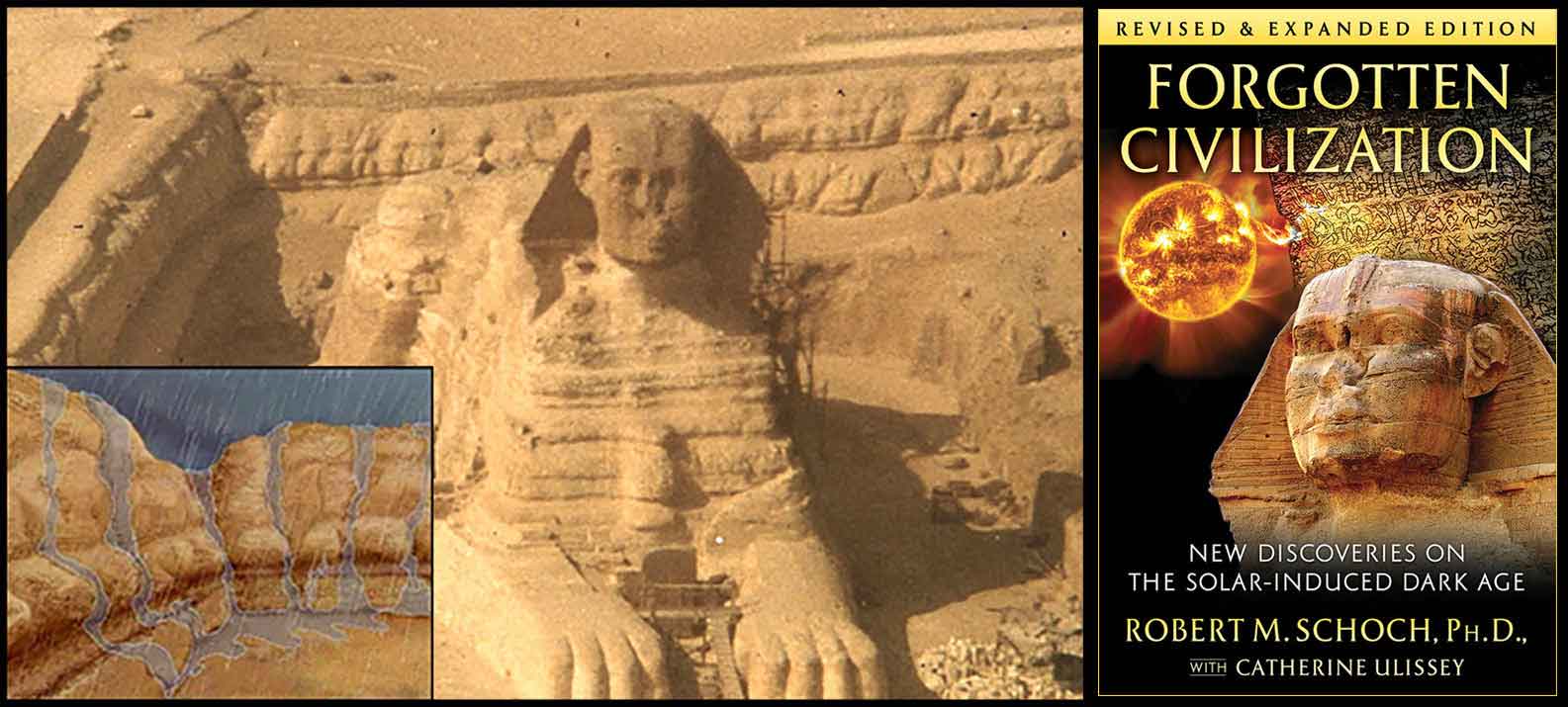
This latest aspect of Dr. Schoch’s three decades of research (not just demonstrating that high civilization goes back thousands of years earlier than traditionally acknowledged, but now also identifying the culprit of the ancient demise) was inspired by an archaeological discovery that I made in 2010.
For several decades, the preeminent U.S. plasma physicist, Dr. Anthony Peratt at Los Alamos National Laboratory, has been studying not just the activities of our Sun, but also ancient petroglyphs worldwide.2 To summarize his work, Dr. Peratt, in modeling plasma discharges in his laboratory, noticed that, at high intensities, plasma takes on distinct shapes: stick-figured men with dots on their sides (a spinning plasma torus with synchrotron radiation extending outward from its center), stick-figured men with bird heads, and cascading cylindrical shapes describe just three of his many examples. What is remarkable about this is that Dr. Peratt further noticed that many ancient petroglyphs depict these same shapes (his published papers offer examples from over 130 countries), suggesting strongly that ancient people witnessed an extreme solar event at some point in our remote past and recorded the shapes they observed in the sky on rock.
Today mild solar storms are seen in the blazing and swirling shapes of the Aurora Borealis
and Aurora Australis. The stronger the storm, the more intense the aurora (charged particles
emitted by the Sun interacting with our atmosphere). In the wake of a micronova
, these
charged particles, Dr. Peratt explains, would take on shapes similar to the ones mentioned.
The discovery I made, which expands upon Dr. Peratt’s research, is that Easter Island’s
previously undeciphered script, known as rongorongo, is comprised of the same plasma
configurations Dr. Peratt has identified. Indeed, a member of Dr. Peratt’s research
team confirmed that our discovery is correct: the rongorongo is solar in nature;
they noticed the correlation years before we did, but intentionally never published
on it.

An explosion from our star c. 9700 BCE sent the world into chaos. The high levels of radiation associated with the event explain the die-off of large mammals that also occurred at this time. The way to survive would have been to go underground, to seek protection within rock, and we see evidence that humans did just this worldwide, with quintessential examples found in the Cappadocia region of Turkey where a network of underground cities that housed tens of thousands of people still exists. Humankind was thrown into a dark age for thousands of years, only to reemerge (amidst megalithic monuments belonging to a much earlier period) with scattered memories and nascent abilities.
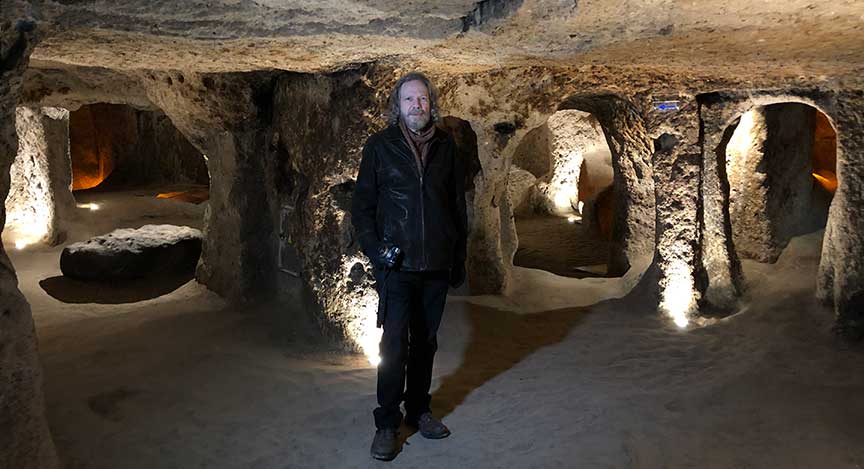
When first presenting his evidence of a water-weathered Sphinx in prehistory, asserting our current civilization is not the first to have arisen on Earth, Dr. Schoch was challenged to present another example of megalithic construction dating back as far as he had pushed the Sphinx (initially he pushed the monument back to c. 7000–5000 BCE; now he pushes it back to before the end of the last ice age, c. 9700 BCE). At the time, he had no corroborating evidence. However, he and the world now have the extremely sophisticated 12,000-year-old megalithic site of Göbekli Tepe in southeastern Turkey, and it has certainly silenced his critics, for it challenges academia regarding the rise of civilization.
How does this all connect to Aquarius? Isotope levels – one way to measure the activity of the Sun – indicate that our star today is showing the same signs of agitation now that it did 12,000 years ago, with nothing comparable in between.3 12,000 years ago, approximately one half of a precessional cycle, our last ice age ended, and advanced culture was brought to its knees, when a river of fire (solar plasma) emanated from our Sun and washed over our planet, leaving little more than large stones standing. Will we be hit again? Geology teaches that it is not a matter of if, but when. The question is, will the world be prepared? And knowing that such an event is coming, what will our civilization leave to posterity?
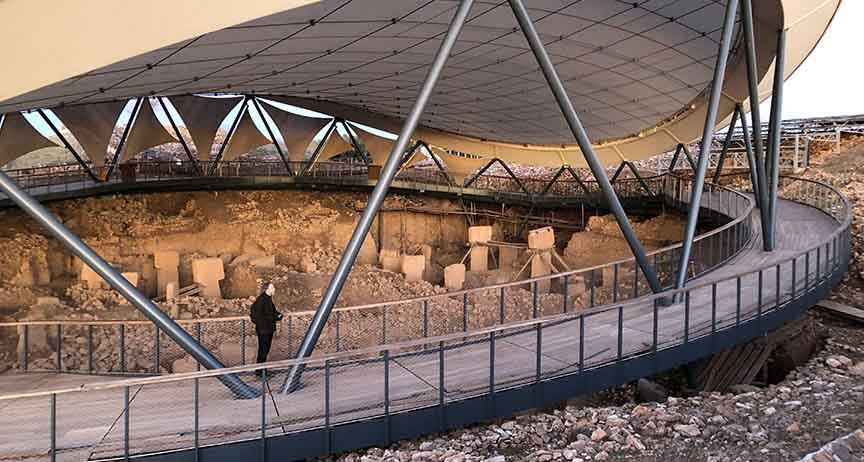
A postscript (7 December 2020):
Robert and I often speculate on what might, on a recurring basis (perhaps on the order of every
12,000 years or so), destabilize our Sun. Our star does not float idly or motionless in space;
rather it travels through a spiral arm of the Milky Way at vast speeds. Some believe our star has
a stellar companion, thus driving (or locking) it into a recurring orbit with another star (see,
for instance, the work of Walter Cruttenden and the Binary Research Institute). This is
an assertion we find interesting, though it has yet to be proven. While still others believe (and this
is not mutually exclusive to that just mentioned) that our star is about to cross the galactic equator
,
and when it does it will traverse a galactic current stream
, much like a rip current in a vast
ocean, where the magnetic charges on one side of the galaxy meet (or collide) with charges from the
other side. Is this crossing of the galactic equator a recurring event for our star? Does such an event,
causing calamity on Earth, regularly repeat due to our Sun being locked in an orbit with another star
(which may be either a massive but dark star and/or one so far away that it has
yet to be detected -- though some suggest Sirius is our Sun's companion)?
If our Sun is part of a binary system, with an orbit that forces it to repeatedly traverse this perilous
region of our Milky Way, this could explain such recurrences of catastrophe on Earth.
Plato, based on more ancient knowledge, suggested that civilization never progresses beyond a certain
point before it is knocked down and forced to begin again. (Robert addresses this topic in
Forgotten Civilization.) I suspect this is what the ancient
artist(s) who carved the basalt moai pictured below might have been trying to say.
The birdman
motif, carved into the shoulder area of the moai,
has already been identified as a plasma configuration
(by plasma physicist Dr. Anthony Peratt). Our galaxy appears to be an enormous, spinning toroid, no
different than small versions studied by Dr. Peratt in his laboratory. As above so below.
This journey could also explain the polarization and disparities seen in our societies today.
If this topic interests you, you can read more in
Forgotten Civilization . And here is a link to a
related article: God and the Sun: The Writing at Göbekli Tepe.
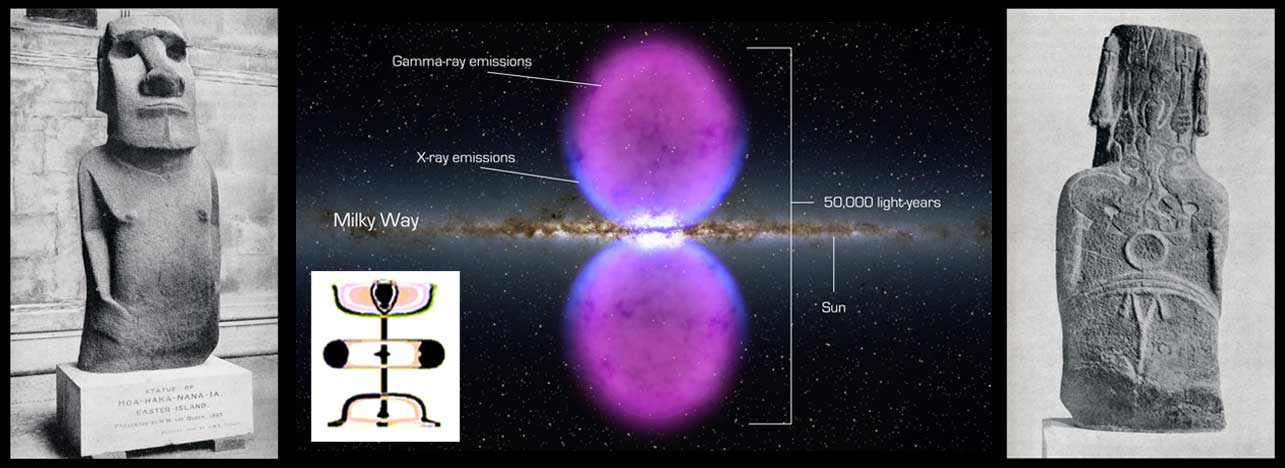
A post postscript (6 March 2021):
Expanding my thoughts on the postscript above, and as they relate to the loss
or death
of the Divine Feminine
... I believe that during the previous half precessional cycle our Sun and
solar system traversed the negatively charged region of the galaxy (negative being equated with
the feminine, as one finds in the discipline of astrology). Then, at 9700 BCE, we entered the
rip current
, which triggered the cataclysms (solar eruptions) that ended the last ice age
and decimated the previous cycle of high civilization. For the last 11,700 years approximately
(from when our solar system emerged from the galactic current stream), our Sun has been swimming in
the positively charged region of the galaxy, thus our shift toward male domination and patriarchy.
I believe ancient references to the death, or loss, of the Divine Feminine
relate to this
galactic (and epic, as history has demonstrated) shift.
Another postscript (23 July 2021):
Continuing the thoughts expressed in the postscripts above,
I believe that what our Sun endures traversing the rapids
, the galactic current sheet
,
is ferocious and wreaks havoc on our Sun and the planets of our solar system. Perhaps it is so
terrifying it is beyond imagination, which, if I am correct in my speculations, may be why we have
blocked previous journeys through this region from our collective psyche. I believe this is why shelters
such as the massive underground
cities of Cappadocia were and will again be needed for survival (similarly, the Ellora and Ajanta caves
of India, the lava tubes of Easter Island, the cliff dwellings of the Anasazi in the U.S. southwest,
enormous caves in China, etc., which, by the way, are all places where pockets of civilization
re-emerged
in the early days post SIDA). These structures are not short-term housing –
and we don’t know how long it takes to cross this region of our Milky Way. I suspect this is why
such a paucity of evidence of prior civilizations exists on Earth; the evidence is incinerated in the gauntlet.
This explains why a high civilization that developed during our Sun’s journey through the prior ages of the
precessional cylce (the portion referred to as the higher ages of the Yuga Cycle, such as the Satya Yuga)
would build massive stone structures, not just as housing for survival but also structures for teaching
posterity, so something potentially helpful might survive the cataclysms that twice every Great Year
befall us. I believe these megalithic structures possess encoded messages and were left for us so we
would learn important information lost during humanity’s journey through the Kali Yuga (the lowest of
the ages, where it appears we are now). But have we learned? Are we learning? I think we are just
beginning to. A case in point is the Khafre Statue, which my husband, Dr. Schoch, discusses in
the 2nd, revised and expanded, edition of
Forgotten Civilization,
released in 2021. The statue
is encoded with plasma symbols that plasma physicists, with the help of cutting-edge high-energy laboratory
technology and supercomputers, are just beginning to recognize (see the work of Dr. Anthony Peratt, cited
and discussed in both editions of Forgotten Civilization). We believe this statue could well have
been pulled from Mehit’s archive (the chamber beneath the Sphinx's paw that Dr. Schoch, working with
John Anthony West and Dr. Thomas Dobecki, located in the early 1990s; this is also discussed in our
book) just before the sands of SIDA set in. It was found very nearby, in a pit in the Valley Temple,
and it may express the most important message (spiritual, though its essence is expressed through
advanced science) left for humanity.
Final postscript on this topic (10 January 2023):
Perhaps the reason why we see on some of the largest and oldest moai the hands of the statue pointing
to the navel region (the belly button
) is
because our eyes are being directed to the galactic equator. This, I speculate, is where (when
the solar system passes through this
region) civilizations die and are
reborn, end and begin anew. (Note: Modern replicas of the moai made for and sold to tourists sometimes
depict the statue
pointing to its phallus. This might similarly be meant to suggest creation and/or fertility.
Message and meaning change through time.)
In closing: For an update on and overview of our research, the 2nd/revised and expanded edition of Forgotten Civilization is now available. It bears the subtitle, New Discoveries on the Solar-Induced Dark Age (which is different from the subtitle of the first edition). The 2021 release offers 150 new/additional pages, including over 40 new b&w photos interspersed throughout the chapters. We hope you like the work we have done.
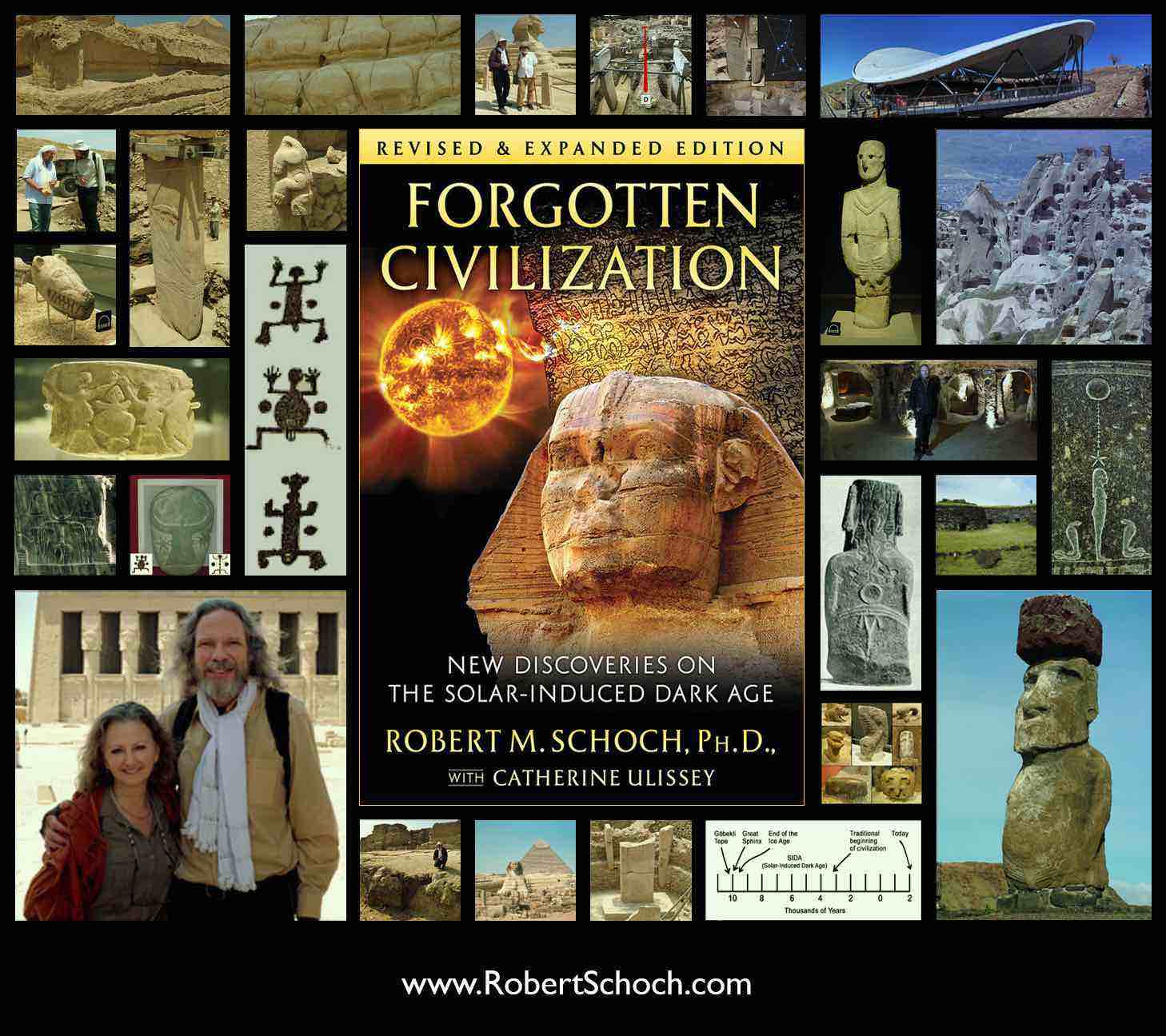
Endnotes:
1. R. M. Schoch, 2012, Forgotten Civilization: The Role of Solar Outbursts in Our Past and Future (Rochester, Vermont: Inner Traditions).
2. Dr. Peratt’s work is discussed and his papers referenced in Forgotten Civilization.
3. See: S. K. Solanki, et al., 2004, Unusual activity of the Sun during recent decades compared to the previous 11,000 years, Nature 431:1084-1087; I G. Usoskin et al., 2007, Grand minima and maxima of solar activity: New observational constraints, Astronomy & Astrophysics, 471:301-30.
- - - - -
Keywords: Geologist who re-dated the Great Sphinx of Egypt, solar outbursts, global plasma petroglyphs, antediluvian civilization, great flood, water-weathering of Sphinx, civilization before civilization, interpreting the rongorongo, rongorongo and plasma configurations.
Banner illustration of Aquarius (top of page) is from W. H. Rosser, 1874, The Stars. London: James Imray and Son.
